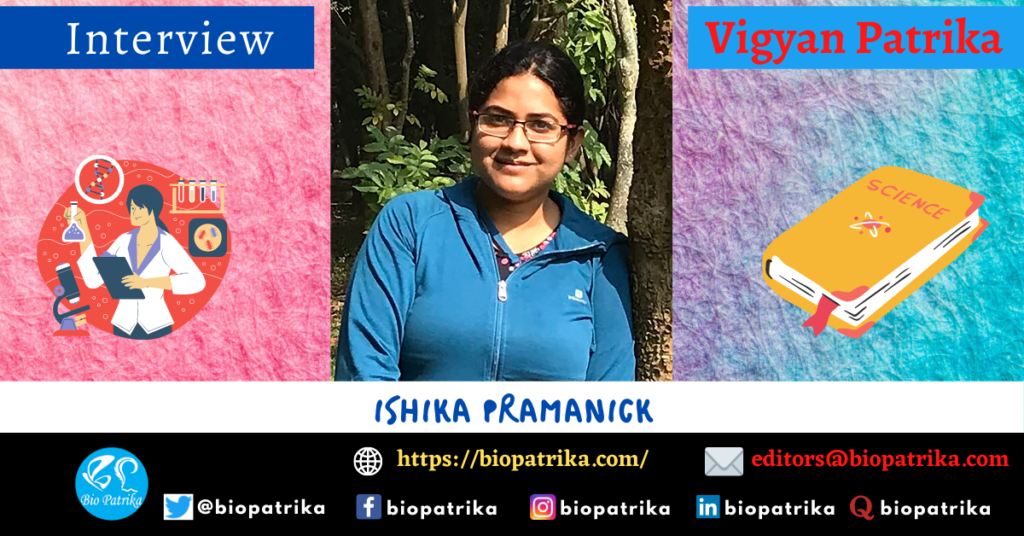Miss Ishika Pramanick’s interview with Bio Patrika hosting “Vigyaan Patrika”, a series of author interviews. Ishika is from Kolkata, West Bengal. She completed her schooling at Ramakrishna Sarada Mission Sister Nivedita Girls’ School, Kolkata. She pursued her B.Sc degree in Microbiology from Scottish Church College, Kolkata and M.Sc degree in Microbiology from the University of Calcutta. Currently, Ishika is a graduate student in the Molecular Biophysics Unit, Indian Institute of Science, Bangalore. She is working on the single-particle cryo-Electron Microscopy (Cryo-EM) field under the supervision of Dr. Somnath Dutta. Here, Ishika talks about her recent work on Conformational flexibility and structural variability of SARS-CoV2 S protein published in Structure.
How would you explain your paper’s key results to the non-scientific community?
Severe Acute Respiratory Syndrome Coronavirus-2 (SARS-CoV2) is one of the deadliest viruses responsible for one of the worst global pandemic in recent times. Spike glycoprotein (S-protein) resides on the surface of SARS-CoV2. It interacts with human angiotensin-converting 2 (hACE2) receptor protein through its Receptor Binding Domain (RBD) to help the virus infect the human body. Spike glycoprotein structure is highly susceptible to pH change; therefore we investigated whether there is any conformational flexibility in S-protein with changes in pH. We selected pH 7.4 (physiological pH), and pH 6.5 and pH 8.0 (near physiological pH) for the study. S-protein is mostly present in two states, (i) “open state” and (ii) “closed state”. The transition from a closed state to an open state regulated by RBD movement, which is important for the proper binding of S-protein to hACE2 receptor. In other words, the higher the number of open state confirmation of S-protein exists, the more relevant for viral infection. We show a significantly higher proportion of open state conformation (68%) at pH 7.4 than at any other pH, which explains why the virus successfully infects humans at physiological pH. We have resolved open state, closed state of S-protein at and near physiological pH. Not only open and closed state, we have also resolved the intermediate conformations of S-protein which illustrates the flexible nature of RBD and NTD. We also provide evidence for heterogeneity in both open and closed conformations, meaning not all S-protein orient in the same way. This heterogeneity generates different binding sites for the neutralizing antibodies to neutralize the virus. Overall, we demonstrate the inherent structural flexibility of S-protein at different pH.

Our findings have the potential to aid the future development of therapeutic agents against the virus considering the versatility of the S-protein structure.
What are the possible consequences of these findings for your research area?
This is the first time, we observed various intermediate conformations of S-protein at near physiological pH, and a high proportion of open state of S-protein at physiological pH using cryo-EM. Our hypothesis is, this pH dependent alteration in S-protein structure could be the mechanism with which the virus evades the immune response. Our results might assist us to understand why there are so many candidates for neutralizing antibodies to treat the infection and why the vaccines available in the market today that target S-protein doesn’t have an efficacy of 100%. Our findings have the potential to aid the future development of therapeutic agents against the virus considering the versatility of the S-protein structure.
What was the exciting moment (eureka moment) during your research?
It’s difficult to pinpoint any particular instance as the eureka moment as I consider the whole experience of this research as a eureka moment. From ideation of the project to taking stunning cryo-EM images to spending many sleepless nights writing up the manuscript was a great learning phase for me. Also, the experience of data processing with smart and wonderful people has been a fantastic journey. We are determined to continue on this journey to unravel more aspects of this deadly virus to help humanity.
What do you hope to do next?
Next, we are in the process of setting up collaborations to focus on deciphering the interaction of S-protein with different drug molecules, neutralizing antibodies, and synthesized peptides at physiological pH. Outcomes from these investigations could pave the path for the inception of new therapeutics against the fatal SARS-CoV2 virus.
Where do you seek scientific inspiration?
To quote Dr. A.P.J. Abdul Kalam, “Dream is not that which you see while sleeping, it is something that does not let you sleep.” The excitement of learning new things is what motivates me to get out of bed every morning. I seek scientific inspiration from all the women working in STEM (Science, technology, engineering, and mathematics), as they work hard to make the world a better space.
How do you intend to help Indian science improve?
Right now, it is too early for me in my career to answer this question. However, with my work and determination, I am hoping to inspire the future generation, particularly women, to take STEM as a career and work towards the welfare of society.
Reference
Ishika Pramanick, Nayanika Sengupta, Suman Mishra, Suman Pandey, Nidhi Girish, Alakta Das, Somnath Dutta. Conformational flexibility and structural variability of SARS-CoV2 S protein. Structure. 2021. PMID: 33932324, PMCID: PMC8086150, DOI: 10.1016/j.str.2021.04.006
Edited by: Sukanya Madhwal
